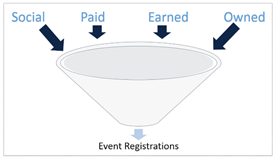Cassie Katz
Cassie Katz is director of marketing for the Professional Services Council in Arlington, Virginia.

Generating interest in a new program your organization is debuting calls for more than mailing an invitation to your subscriber list. Use these strategies and tools to achieve a sold-out event.
Getting a new association event off the ground is no small matter. It takes a team effort to conceptualize and introduce an event in what is often already a crowded space. Take advantage of these tips and tricks to ensure success.
Ideally, schedule at least six months to plan and market a big event the first year. Ask a series of key questions at the outset, including:
Treat an event like a business product and assign success metrics to it. Going through this exercise may even help you determine that an event is not the best tactic for what you’re trying to achieve, saving you valuable time and resources. We use an event capture form, a one-pager with key event details and planning information, to ensure essential upfront questions are answered. Once approved, the one-pager is also shared with staff so everyone is aligned with the event overview and objectives.
Work with your membership team to ensure the event location is conducive to where your target audience is—or where they’d be willing to go. For example, we held a half-day conference an hour away from our office because more of our target audience was in that region. We secured more recognizable speakers because the venue was convenient to where these presenters worked. Having noteworthy speakers elevated the importance of our event, which eventually sold out. Had we not done the proper research before deciding on a site, our results could have been much different. Creating a member planning committee is another good way to get ideas and insight into what resonates with potential attendees. Other early steps that pay off:
Write a creative brief. The visual component of branding drives engagement and makes or breaks someone’s decision to click through to learn more and ultimately register. A creative brief guides design decisions to ensure that the logo and branding best capture the event. It’s also essential for the designers working on both your print collateral and the event’s website. Make sure it includes event and target audience descriptions, differences between your event and similar ones, design parameters, examples of logos and designs you like, and webpage essentials.
Nail down sponsorships and strategic partnerships. Once you have the logistics worked out, define what sponsorship opportunities are available and map out who your top prospects are. Create a simple one-pager you can send to potential partners at least three months in advance. Not only will this help you cover costs and increase your revenue, but it also provides you with additional marketing opportunities if your sponsor agrees to promote the event through their own channels.
Partnerships are another great way to maximize visibility. Determine which noncompeting organizations, media companies, or other groups may be interested in a mutually beneficial trade. For example, if you have a sponsorship valued at $1,000, you could trade that for $1,000 worth of advertising in the partner’s newsletter. This casts a bigger net for potential attendees and validates your event by showing that other organizations are participating.
Leverage multiple marketing channels and schedule at least two months of promotion to amplify visibility and registration opportunities. The SPEO marketing model groups your marketing initiatives into four key buckets:

Paid. Traditional advertising such as banner ads and retargeting ads can help keep your event top of mind. The Marketing Rule of 7 states that a prospect needs to “hear” the advertiser's message at least seven times before they'll act, so the more visibility you can get, the better.
Earned. Develop a list of potential media attendees and entice them with research or something newsworthy that will be released at your event. Send a press release at least one week in advance to get on their editorial calendars.
Owned. What channels does your organization own to help market the event? This could be email lists, banners on your website homepage, email signatures (event banners at the bottom of staff emails), newsletters, publications, or podcasts. While emails remain an essential part of an event marketing campaign, I’ve seen a resurgence in non-digital tactics such as postcard mailings. If you have a database with addresses, use them. Generate a unique link code through bit.ly or a similar tool to track the effectiveness of the mailing. Generate word-of-mouth marketing by including a “forward to a friend or colleague” link at the bottom of all event emails.
On the day of your big event, you should already be thinking about how you can leverage the activities to help you market the event next time. Include the event hashtag and speakers’ Twitter handles in the agenda so attendees feel compelled to bring the conversation online. Have a dedicated “Tweeter” who can give live updates and share photos. Enlist a professional photographer to ensure you’ll have good photos for next year’s marketing efforts, and send them to members of the press who attended.
Stay sharp afterward. The days following an event are an essential time to compile feedback from attendees and harness their enthusiasm into a call to action. Compile your marketing stats to see what channels and tactics worked best and what needs improvement for next time. A debrief with staff can also help establish lessons learned.